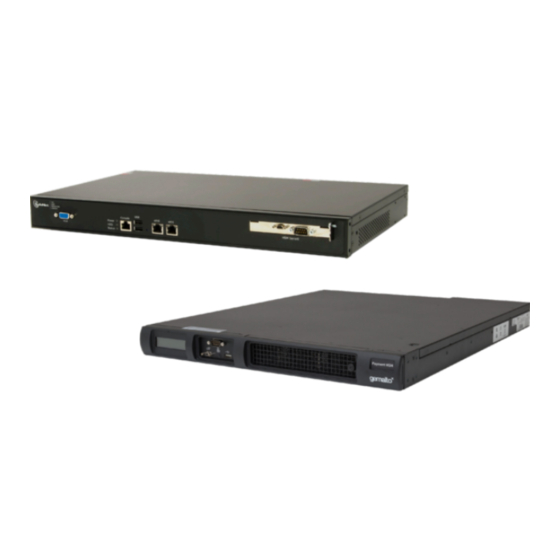
Gemalto SafeNet ProtectServer PCIe HSM Installation Manual
Hide thumbs
Also See for SafeNet ProtectServer PCIe HSM:
- Installation and configuration manual (80 pages)
Table of Contents
Advertisement
Quick Links
Advertisement
Table of Contents

Summary of Contents for Gemalto SafeNet ProtectServer PCIe HSM
- Page 1 SafeNet ProtectServer PCIe HSM Installation Guide...
- Page 2 Gemalto does not and shall not warrant that this product will be resistant to all possible attacks and shall not incur, and disclaims, any liability in this respect.
- Page 3 © 2016 Gemalto. All rights reserved. Gemalto and the Gemalto logo are trademarks and service marks of Gemalto N.V. and/or its subsidiaries and are registered in certain countries. All other trademarks and service marks, whether registered or not in specific countries, are the property of their respective owners.
- Page 4 Revision History Revision Date Reason 14 March 2016 Release 5.2...
-
Page 5: Table Of Contents
Introduction ........................1 Product Overview ........................... 1 About This Manual ......................... 1 Chapter 2 SafeNet ProtectServer PCIe HSM Installation ............. 3 Installation Summary ........................3 Adapter Features ..........................3 The Card Faceplate ........................3 Battery and Jumper Headers ....................... 4 Installing the Adapter ........................ - Page 6 THIS PAGE INTENTIONALLY LEFT BLANK...
-
Page 7: Chapter 1 Introduction
This manual is provided as an instructional aid for the installation of a SafeNet ProtectServer cryptographic services hardware adapter. Installation of the associated SafeNet ProtectServer PCIe HSM Access Provider package (PTKpcihsm2) is described in the companion manual, SafeNet ProtectServer HSM Access Provider Installation Guide. The SafeNet PCI HSM Access Provider package includes the device driver. - Page 8 THIS PAGE INTENTIONALLY LEFT BLANK...
-
Page 9: Safenet Protectserver Pcie Hsm Installation
Install the SafeNet application programming interface (API) or net server software supplied with the product. Adapter Features The SafeNet ProtectServer PCIe HSM is a standard PCIe device that can be fitted into any spare PCIe slot on the motherboard in formats x4, x8, or x16. The Card Faceplate... -
Page 10: Battery And Jumper Headers
The USB Port The USB port is used to connect a serial device, such as a smart card reader, to the card using the included USB-to-serial adapter. The MSDM Connector The micro-D subminiature (MDSM) connector is not used. Battery and Jumper Headers The card is also equipped with a battery and a series of jumper headers located at the rear of the card, as illustrated below: The Battery... -
Page 11: Installing The Adapter
Installation Guide for both Windows and Unix/Linux systems. Smart Card Reader Installation The SafeNet ProtectServer PCIe HSM offers functionality supporting the use of smart cards. To make use of these features, you must use a SafeNet-supplied smart card reader. Smart card readers, other than those supplied by SafeNet, are not supported. - Page 12 Installing the USB smart card reader To install the USB card reader, simply plug the card reader into the HSM USB port, as illustrated below. Installing the legacy card reader To install the smart card reader, use the included USB-to-serial cable to connect it to the HSM USB port on the card faceplate.
-
Page 13: Completing Installation
Completing Installation Following the PCI HSM Access Provider installation, to make use of the ProtectServer, you will need to install the supplied SafeNet API or net server software. Please refer to the installation instructions in the appropriate manual, such as the SafeNet ProtectToolkit C Installation Guide. -
Page 14: Chapter 3 Troubleshooting
Chapter 3 Troubleshooting Overview The most common problem encountered with installing the SafeNet ProtectServer PCIe HSM is that the device driver is not loaded or functioning correctly. Should you encounter any difficulties, first check that you have followed all the installation instructions in this manual and the HSM Access Provider Installation Guide. -
Page 15: Solution
Solution Confirm that the adapter(s) are firmly seated in the PCIe slot, then uninstall the HSM Access Provider package. Following this, perform a fresh install of the HSM Access Provider package. Problem When operating multiple adapters under Windows 2000 or later, the adapters run slowly or even stall. -
Page 16: Chapter 4 Hardware Reference
Chapter 4 Hardware Reference Adapter Modification for External Tamper Detectors Provision has been made to allow users to connect additional tamper detection devices using the tamper input header, located on the rear of the card, as illustrated below. To fit an external tamper detection device, such as a micro switch on the cover of the host system, first remove the default jumper/shunt that bridges the two posts in the ProtectServer adapter's tamper input header. -
Page 17: Testing The Battery
Testing the battery You can use the utilities provided with the adapter to query the state of the battery, but it reports only “low” or not (see below). For example, if ProtectToolkit C is being used, then the ctconf utility displays the state of the battery (Good/Low). See the Administration Guides for the software you are running for details on how you can check the battery status.

Need help?
Do you have a question about the SafeNet ProtectServer PCIe HSM and is the answer not in the manual?
Questions and answers